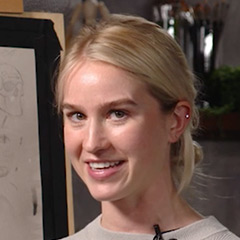
Portrait Drawing: Finishing Touches
Savannah Tate CuffIt’s challenging to know when a drawing is finished and it’s time to step away, and for the artist, it can be hard to let go. Artist Savannah Tate Cuff shares her thoughts on when to stop with an example drawing made from a live model. In the drawing, Savannah’s block-in (the phase of creating two-dimensional areas and marking terminators, contours, and proportions) is completed. She’s rendered each area, fully focusing on each section and not going back to previous sections with additional modeling. At this point, she steps away from the drawing so she can assess it as a whole. There may be, Savannah says, “20 million things” that jump out and that she might not like, but she stresses that it’s just as important to move on. Practice and repeated drawings are what will make you a better artist, not correcting every flaw you might think you see.
That said, in Savannah’s drawing, she does select a couple of areas to continue working on. Those are the model’s upper lip area, which she’ll make slightly narrower, and an area to the side of the chin that Savannah evaluates as needing more modeling and rendering. Without getting caught up in what she calls “that vortex of second-guessing,” a few carefully chosen final refinements can be helpful. However, too much reworking of your drawing won’t necessarily make it better, and can leave it feeling overworked and lifeless. One of her most valuable lessons as an artist, Savannah says, is that once you’ve finished rendering, step back, change a few things, and then call it done!
Hi, I'm Savanna Tate Cuff. And I'd like to talk about finishing a drawing. That's something that is very challenging to know when to let go of a drawing. To know when to stop rendering, stop modeling and just take a step away from the drawing. So I have my drawing here and I have done the block in that two dimensional phase where I looked at the flat shapes and marked my terminators, contours, got in my proportions.
I rendered each section by section fully focusing on each section that I was rendering. And I was really trying hard not to go back to a previous section that I had already rendered as I was working on that section that I was modeling. So now's the time that I can step away from my drawing and assess everything together as a whole. I might find that there are 20 million things that stick out to me that I don't like, but I think at the end of the day it's also just as important to move on and repeating that drawing process over time will make you stronger as a draftsman. So with this drawing, when I stepped back from it there were a couple things in particular that I wanna change.
But for the most part, I'm going to keep everything like it is. The two things that I found on this drawing in particular that I'd like to change was the upper lip. I want to just make it slightly narrower. As I modeled, it grew a little bit and I want to render this section a little bit more carefully and model that down. But the most important thing is not to get caught up and that vortex of second guessing.
You can spend forever going around and around on things. And sometimes you might not necessarily be making it better. You might actually end up over modeling and destroying some of that delicate work that you put in in the first pass on your portrait or figure or whatever it is that you're drawing. So one of the things that I've learned that I've found most valuable is that once you've finished rendering to take a step back change a few things, but then call it done.

Share tips, start a discussion or ask other students a question. If you have a question for an expert, please click here.
Already a member? Sign in
No Responses to “Portrait Drawing: Finishing Touches”